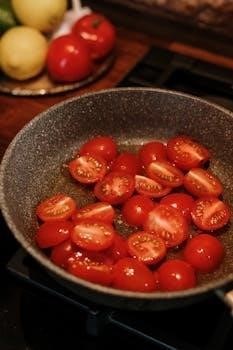Mirro Pressure Cooker Instructions⁚ A Comprehensive Guide
Welcome! This guide provides comprehensive instructions for using Mirro pressure cookers. We’ll cover everything from understanding the components and safety features to operating, maintaining, and troubleshooting your cooker. Whether you’re a novice or experienced cook, this guide will ensure safe and efficient use.
Mirro pressure cookers have a long and storied history, becoming a kitchen staple for generations seeking efficient and effective cooking methods. Known for their durable aluminum construction, Mirro cookers were particularly popular for canning and preserving foods, ensuring safety and extending shelf life. Vintage models, often featuring a weighted regulator or “jiggler,” are still sought after for their reliability, though modern models offer enhanced safety features. This guide primarily focuses on providing clear and concise instructions for operating and maintaining both vintage and newer Mirro pressure cookers and canners. Whether you’re using a classic Mirro-Matic or a more recent design, understanding the specific features and functionalities of your model is crucial. We will also address considerations specific to vintage cookers, noting that some older techniques might not align with current safety standards. Ultimately, this introduction aims to equip you with the knowledge to confidently and safely use your Mirro pressure cooker.

Understanding the Basics
Before operating your Mirro pressure cooker, familiarize yourself with its core components and safety mechanisms. Proper understanding ensures safe and efficient cooking. This section details essential parts and highlights safety features to prevent accidents during pressure cooking.
Key Components of a Mirro Pressure Cooker
A Mirro pressure cooker consists of several key components working together to create a sealed, pressurized cooking environment. The main parts include the pot, typically made of durable aluminum alloy, and a lid that locks securely. The lid features essential safety mechanisms like a pressure release valve, often a red plastic plug designed to blow out if excessive pressure builds up, preventing dangerous situations.
The weighted regulator, sometimes referred to as a “jiggler,” maintains the desired pressure level by releasing steam. Gaskets ensure an airtight seal between the lid and pot. Handles provide a safe grip, while a rack inside the pot elevates food, preventing burning and ensuring even cooking. Knowing these components is vital.
Understanding each part’s function allows for safe and efficient operation, whether you have a vintage or modern Mirro pressure cooker. Familiarize yourself with these components before your first use.
Furthermore, different models may have slight variations, consulting your model’s manual is always recommended for specific details and safety precautions. Regular inspection of these parts is important.
Safety Features⁚ Ensuring Safe Operation
Mirro pressure cookers incorporate multiple safety features designed to prevent accidents and ensure safe operation. The primary safety mechanism is the pressure release valve, typically a red plastic plug. This valve is designed to release excess pressure if it builds up beyond safe levels, preventing potential explosions. Some older models use a weighted regulator, or “jiggler,” to maintain the desired pressure by releasing steam. This regulator is calibrated to a specific pressure (usually 15 PSI).
The lid locking mechanism is another crucial safety feature, preventing the lid from being opened while pressure remains inside the cooker. Gaskets ensure an airtight seal between the lid and the pot, maintaining consistent pressure and preventing leaks. Additionally, a fusible plug may be present, designed to melt and release pressure in extreme overpressure situations.
Always inspect these safety features before each use to confirm they are clean and functioning properly. Never attempt to modify or disable these features, as they are essential for safe operation. Understanding and respecting these safety mechanisms is paramount when using a Mirro pressure cooker.

Operating Your Mirro Pressure Cooker
Operating your Mirro pressure cooker requires careful attention to detail for safe and effective cooking. This section covers the step-by-step instructions and the pressure settings to ensure your meals are perfectly cooked and safe to consume.
Step-by-Step Instructions for Use
Before you start, ensure your Mirro pressure cooker is clean and all parts are in good working order. Begin by adding the appropriate amount of liquid to the cooker, as specified in your recipe. Place the trivet or rack in the bottom to prevent food from sticking and ensure even cooking, except for certain recipes like applesauce.
Next, add your food items to the cooker. Ensure not to overfill; leave adequate space for steam to circulate. Secure the lid tightly, aligning the arrows or marks as indicated in your cooker’s manual. Make sure the gasket is clean and properly seated to ensure an airtight seal.
Place the cooker on a stovetop burner over medium-high heat. Allow the pressure to build; you’ll notice steam escaping from the vent pipe. Once a steady stream of steam is released, place the pressure regulator (weight) on the vent pipe. The cooker will now begin to pressurize.
Monitor the pressure gauge or regulator. Once the desired pressure is reached, reduce the heat to maintain that pressure consistently. Begin timing your cooking process according to your recipe. If pressure drops, increase heat. If pressure rises too high, slightly lower heat. After cooking, turn off the heat and let the pressure release naturally, or use the quick-release method if your model has one.
Finally, before opening, ensure all pressure is released. Carefully remove the weight, and then open the lid away from you to avoid steam burns.
Pressure Settings and Cooking Times
Understanding pressure settings and cooking times is crucial for successful pressure cooking with your Mirro cooker. Mirro cookers typically operate at 15 psi, which is suitable for most recipes and canning purposes. However, always consult your recipe for specific pressure recommendations.
Cooking times vary significantly depending on the food type and quantity. Tender cuts of meat require shorter cooking times than tougher cuts. Vegetables also cook quickly under pressure, often in just a few minutes. Overcooking can lead to mushy textures, while undercooking may result in food that is not fully cooked.
For example, beans typically require 20-40 minutes at 15 psi, while chicken pieces may only need 8-12 minutes. Refer to reliable pressure cooking charts or recipe books for recommended cooking times for specific ingredients. It’s better to start with shorter cooking times, as you can always add more time if needed.
Altitude also affects cooking times. At higher altitudes, water boils at a lower temperature, requiring longer cooking times. Increase cooking times by approximately 5% for every 1,000 feet above sea level. Accurate timing, paired with the correct pressure setting, ensures perfectly cooked meals every time with your Mirro pressure cooker.
Always remember that these are general guidelines; you should consult the recipe. Your Mirro pressure cooker is a powerful tool, and understanding these settings will greatly improve your cooking.

Maintenance and Care
Proper maintenance ensures your Mirro pressure cooker’s longevity and safe operation. Regular cleaning and careful storage are key. Addressing common issues promptly prevents major problems. By following these guidelines, you can keep your pressure cooker in top condition.
Cleaning Your Mirro Pressure Cooker
Maintaining a clean Mirro pressure cooker is crucial for both its performance and your safety. After each use, allow the cooker to cool completely before disassembling any parts. Wash the pot and lid with warm, soapy water, using a non-abrasive sponge to avoid scratching the aluminum. Pay close attention to the sealing ring, ensuring it’s free from food particles or residue, as this can affect its ability to create a proper seal.
The vent pipe should also be thoroughly cleaned to prevent blockages, which can lead to dangerous pressure build-up. A small brush or pipe cleaner can be used to clear any debris. Check the overpressure plug (if your model has one) and remove it for cleaning as well. Ensure all parts are completely dry before reassembling the pressure cooker.
For stubborn stains or discoloration, a paste of baking soda and water can be gently applied. Avoid using harsh chemicals or scouring pads, as they can damage the cooker’s surface. Regular cleaning not only keeps your pressure cooker looking its best but also ensures its safe and efficient operation for years to come.
Troubleshooting Common Issues
Even with careful use, you may encounter issues with your Mirro pressure cooker. One common problem is the failure to reach the correct pressure. This is often due to an improperly sealed lid, a worn sealing ring, or insufficient liquid in the cooker. Ensure the lid is correctly aligned and locked, and that the sealing ring is clean and pliable. If it’s cracked or hardened, it needs replacement.
Another issue is steam leaking from the sides. This typically indicates a faulty sealing ring or damage to the pot’s rim. Inspect both for imperfections. If food splatters from the vent pipe, it suggests overfilling the cooker or using ingredients that expand excessively, like beans or rice. Reduce the fill level and adjust recipes accordingly.
If the pressure cooker releases pressure prematurely, the heat may be too high, or the vent pipe may be blocked. Lower the heat and check the vent pipe for obstructions. Remember to consult your manual for specific troubleshooting steps related to your Mirro model. If problems persist, seek advice from a qualified appliance repair technician.

Resources
Find Mirro pressure cooker manuals online for various models. Explore online retailers for replacement parts like sealing rings and pressure regulators. Consider vintage Mirro cooker safety and consult updated canning guidelines for safe practices.
Finding Manuals and Replacement Parts
Locating manuals and replacement parts for your Mirro pressure cooker is essential for its proper and safe operation. Start by searching online for “Mirro pressure cooker manual” along with your specific model number, often found on the cooker’s base or lid. Several websites offer downloadable manuals, sometimes as a courtesy to users who have lost their original copies.
For replacement parts, such as sealing rings, overpressure plugs, and pressure regulators, online retailers specializing in pressure cooker parts are a great resource. Be sure to verify the part number to ensure compatibility with your Mirro model.
Consider checking appliance parts websites where you can often find diagrams and parts lists to help you identify the correct items. If you are unsure, consulting with a knowledgeable appliance repair technician can help identify the correct parts and ensure proper installation. Always prioritize safety when replacing parts, and ensure they are genuine replacements.
Vintage Mirro Pressure Cooker Considerations
Using a vintage Mirro pressure cooker requires extra caution. These older models often lack the advanced safety features found in modern cookers, so careful inspection and understanding of their operation are crucial. Firstly, thoroughly examine the cooker for any signs of wear, damage, or corrosion, especially around the sealing surfaces and pressure release mechanisms.
Locate and carefully review the original manual. Note that some techniques recommended in older manuals may no longer be considered safe by today’s standards. Pay close attention to pressure settings, as older Mirro cookers often operated at 15 psi. Ensure that the pressure regulator (often a weighted “jiggler”) is clean and moves freely.
Before each use, test the safety valve to ensure it’s not blocked. It’s wise to replace the sealing ring if it’s brittle or cracked. Always monitor the cooker closely during operation, and never leave it unattended. If in doubt about the safety of using a vintage cooker, consider investing in a newer model with enhanced safety features.


